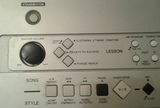Yamaha PSR-E323
| Yamaha PSR-E323 | |
|---|---|
 Yamaha PSR-E323 | |
| Manufacturer | Yamaha |
| Dates | 2009 |
| Technical specifications | |
| Polyphony | 32 notes |
| Timbrality | 16-part multi-timbral, General MIDI compatible |
| Synthesis type | PCM sample-based synthesis (Yamaha Advanced Wave Memory) |
| Velocity expression | 3-level adjustable dynamic velocity |
| Storage memory | 64 Mbit wave sample ROM 373 KiB EEPROM |
| Effects | Reverb Chorus Dynamic stereo sampling (for piano sounds) |
| Input/output | |
| Keyboard | 61 keys |
| External control | MIDI |
The Yamaha PSR-E323, also known as the YPT-320, is an electronic keyboard manufactured by the Yamaha Corporation in 2009. It is a basic home keyboard intended for learning and personal use.
Official description
The PSR-E323 is a touch sensitive instrument that features 482 dynamic, authentic voices, with 361 XGlite voices, 12 drum kits and a sound effect kit. The PSR-E323 also has 106 accompaniment styles and 102 built-in songs.[1]
Overview
The Yamaha PSR-E323 is an entry-level home electronic keyboard dedicated for beginner, learning and personal usage. It is positioned in the low-end class, competing with similar products such as Casio LK-220 and CTK-3000.
The keyboard features a velocity-sensitive keys with adjustable sensitivity setting, a total of 482 instrument sounds including stereo-sampled piano and Yamaha XG soundset, a set of 106 different auto-accompaniment rhythms, built-in lesson system for practicing, stereo bass reflex speakers, as well as over 100 built-in songs.
Like most electronic keyboards in general, the PSR-E323 is compatible with MIDI standard, with an integrated MIDI input/output jacks for connecting to a computer or other electronic instruments.
Sound engine
The keyboard contains a scaled-down version of Yamaha's Advanced Wave Memory (AWM) tone generation system, which is a PCM sample-based synthesis engine. The samples are an adaptation of Yamaha's earlier PortaTone series of home keyboards produced between 1997 and 2006, as well as the MU-series sound modules produced from 1994 to 2002.
It features a 32-note polyphony with 16-part multi-timbral support and Yamaha XG Lite sound set.
One notable feature of the keyboard is "Portable Grand", a function that instantly sets the keyboard to a stereo-sampled piano sound. The piano are digital samples of a Yamaha grand piano dating back to the early-1990s, and was formerly used in digital pianos at the time such as YFP, YPP, and YPR series, as well as early models of Clavinova.
Successors
Yamaha has produced a series of similar keyboards as direct successor to the PSR-E323; the PSR-E333 (2011), which maintains otherwise identical design, features and sounds, but with a black color, 3D stereo function, and a new plug-and-play USB connection replacing the traditional MIDI in/out ports; the PSR-E343 (2013), featuring a redesigned panel layout, new sounds, audio input (AUX) connection, and iOS device compatibility; the PSR-E353 (2015), featuring the same design and functions as its predecessor but with improved sound engine, enhanced speaker system and grey finish; the PSR-E363[2] (2017) featuring a major redesign and improved sound system, alongside a 76-note version (PSR-EW300), and the PSR-E373[3] (2020) featuring a new sound engine with Super Articulation Lite voices and a new concert grand piano sound, alongside its 76-note variant, the PSR-EW310.
Gallery
See also
External links
References
- ^ "PSR-E323". USA Yamaha. Retrieved 2016-01-27.
- ^ "PSR E363 Description and Specs". 2019-10-25. Retrieved 2019-12-26.
- ^ "PSR-E373 Portable 61-key Keyboard - Yamaha USA". usa.yamaha.com. Retrieved 2020-12-03.



